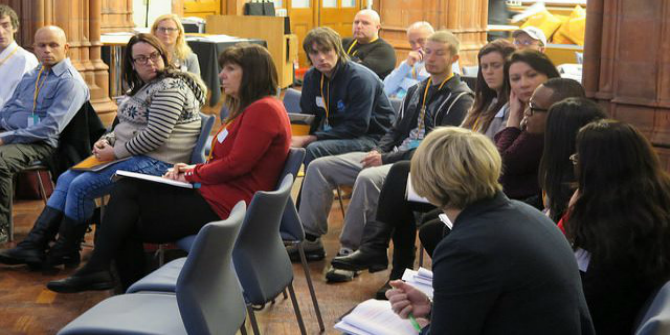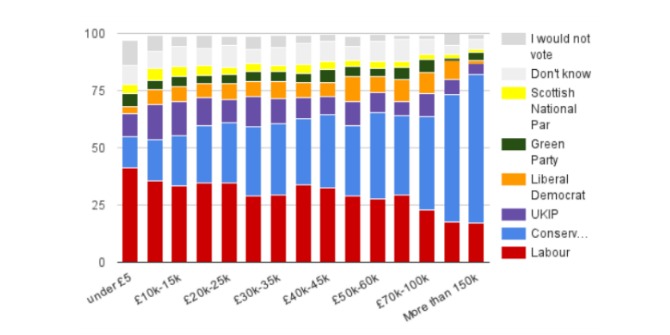 While the Yes side seems to have retained the gains that it made during the winter, it apparently does not have the continued momentum it seemingly still needs if it is to achieve victory. However, when considering those who still have not made up their minds and those who acknowledge they may change their minds come September, the votes of just under half of Scots are still potentially up for grabs. But, nevertheless, John Curtice thinks it will take a Herculean campaign from here on out (or an especially bad one) to change things.
While the Yes side seems to have retained the gains that it made during the winter, it apparently does not have the continued momentum it seemingly still needs if it is to achieve victory. However, when considering those who still have not made up their minds and those who acknowledge they may change their minds come September, the votes of just under half of Scots are still potentially up for grabs. But, nevertheless, John Curtice thinks it will take a Herculean campaign from here on out (or an especially bad one) to change things.
Today marks the opening of the ‘official’ phase of the independence referendum campaign in Scotland. No, that does not mean that campaigning is only now beginning get under way – it has been going on in earnest for at least the last twelve months. It simply means that from now on the money that the two campaigns and the political parties spend on the referendum has to be accounted for and is subject to an overall statutory limit.
The two official campaigns have a budget of £1.5m each. At the same time, the principal political parties backing a Yes vote can also spend another £1.5m or so between them, as can those campaigning for a No one.
Political scientists often wonder whether campaigns matter. That question would seem particularly pertinent for a referendum on a subject that has been the subject of argument for forty years and which for many touches on upon fundamental feelings about who they feel they are, Scottish or British. Perhaps that means there is little prospect of many people being persuaded to change their views in the next 16 weeks – and thus of the balance of opinion shifting much in either direction?
Indeed for much of last year there was little or no movement in the polls. Pollster after pollster reported figures that were much the same as their previous poll had uncovered. Throughout the year, the average level of support for Yes once the Don’t Knows were excluded hovered around No 61%, Yes 39%. True, the polling companies consistently disagreed with each other about exactly where the balance of opinion lay – one company, Panelbase, typically reported a 44-45% Yes vote when at the same time TNS BMRB and Ipsos MORI were estimating it as being no more than between 34% and 38%. But each individual polling company’s estimate barely changed at all.
However, public opinion finally shifted during the early months of this year. By March all of the polling companies were reporting somewhat higher figures for Yes than they had done three or four months previously. On average the polls were now putting the Yes side on 43%, and No on 57%. Hardly a big movement, perhaps, but certainly enough to change the mood of the campaign.
What happened during that period to engender such a shift? Probably the key development was the publication at the end of November of the Scottish Government’s White Paper. The first signs of an increase in Yes support emerged soon after, and once Christmas was over became quite clear. Laying out its vision of independence in full seems to have helped the Scottish Government gain some converts to its side of the argument.
Then in the middle of February the Chancellor of the Exchequer announced that neither he nor his Liberal Democrat and Labour counterparts were willing to allow an independent Scotland to share the pound as a formal currency union. We were told that undecided voters would switch to No once they learnt they would not be able to keep the pound. Instead many undecided voters, along with those already committed to voting Yes, reckoned the Chancellor was bluffing, while some did not take kindly to being ‘bossed about’ by London. The polls drifted a little bit further in the Yes side’s direction.
However, in more recent weeks the polling needle appears to have become stuck again. The current polling average for the five companies that have been polling regularly in recent weeks is the same as the position at the end of March, Yes 43%, No 57%. In short, while the Yes side seems to have retained the gains that it made during the winter, it apparently does not have the continued momentum it seemingly still needs if it is to achieve victory.
Of course, one difference between the next 16 weeks and the last 16 months is that, come September, everyone will have to make up their mind. Meanwhile, so far there is no sign of the number of Don’t Knows diminishing in the polls. However, at around 15% or so in most polls it would seem that the undecideds are not that numerous in the first place.
However, it is probably a mistake to think of the Don’t Knows as a single, undifferentiated group. Rather, voters lie at various points on a spectrum of indecision. More than one poll suggests that in addition to the 15% who have no idea at all what they will do, there is at least another 15% or so who do have an idea but have not made up their mind. And then amongst the remaining 70% there is another similar sized group who think they have made a decision, but acknowledge they might just change their minds.
So maybe the votes of just under half of Scots are still potentially up for grabs. But if either side is to make progress in the next 16 weeks they will need not simply to secure the backing of those who are currently wholly undecided, but to persuade voters who do have quite a strong inclination to vote one way or the other to change their minds. That suggests that if the next 16 weeks are to make a difference one side or the other is going to have to fight a very good (or very bad!) campaign indeed.
Note: This article gives the views of the author, and not the position of the British Politics and Policy blog, nor of the London School of Economics. Please read our comments policy before posting.
 John Curtice – Strathclyde University
John Curtice – Strathclyde University
John Curtice is Professor of Politics, Strathclyde University. Full details and further analysis of the polling in the Scottish referendum are to be found at his ESRC funded website, whatscotlandthinks.org.







